As a Chinese tile supplier working with importers worldwide, I’ve noticed more and more of our partners expanding their product lines to include both tile and wood flooring. This makes perfect sense – both options have loyal fans and specific advantages that make them ideal for different applications.
In today’s competitive market, successful importers need to understand the complete picture of tile vs wood flooring to serve their customers effectively. Each option has unique strengths, limitations, and market opportunities that smart businesses can leverage.
This comprehensive guide will walk you through everything you need to know about tile vs wood flooring – from the various types available to detailed cost comparisons and regional market insights. By the end, you’ll have a clear understanding of how to position these products for maximum success in your market.
Overview: Tile vs Wood Flooring Fundamentals
Before diving into specifics, let’s look at the basic differences between tile and wood flooring.

Tile flooring is:
- Made from clay or natural stone materials
- Typically hard and cool underfoot
- Highly water-resistant
- Available in countless designs and formats
- Generally more durable in high-moisture environments
Wood flooring is:
- Crafted from timber or wood-based products
- Naturally warm and somewhat soft underfoot
- More vulnerable to moisture
- Available in various species and finishes
- Often preferred for living areas and bedrooms
The global flooring market continues to grow, with both tile and hardwood maintaining strong positions. Porcelain tile remains dominant in warmer climates and commercial settings, while wood flooring holds strong in residential markets, especially in temperate regions.
Types of Tile Flooring
Understanding the variety of tile options is essential when comparing tile and wood flooring. Here are the main categories your customers might consider:
Ceramic Tiles
Ceramic tiles are made from clay that’s been kiln-fired and usually glazed. They offer:
- More affordable pricing than porcelain
- Easier cutting and installation
- Wide variety of colors and designs
- Good durability for residential use
- Lower water resistance than porcelain
Porcelain Tiles

Porcelain is a premium type of ceramic made from more refined clay and fired at higher temperatures:
- Extremely durable and dense
- Very low water absorption (under 0.5%)
- Suitable for indoor and outdoor use
- Available in through-body or glazed varieties
- Higher price point than standard ceramic
Natural Stone Tiles
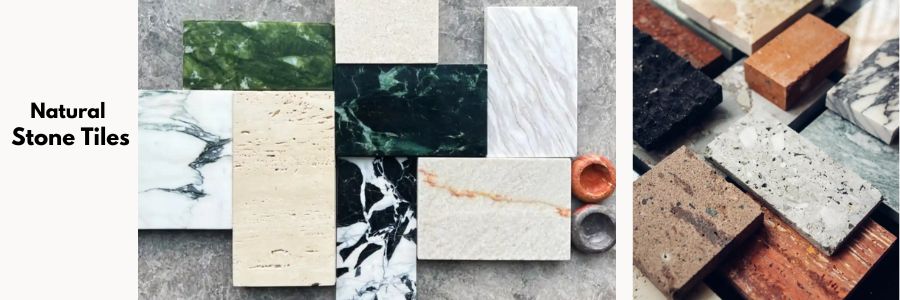
Stone tiles are quarried directly from the earth and include:
- Marble: Elegant with distinctive veining
- Granite: Extremely hard with speckled appearance
- Travertine: Natural pitted look with earthy tones
- Slate: Rustic, textured surface with natural cleft
- Limestone: Soft, natural appearance with fossil impressions
Each stone type has unique properties regarding hardness, porosity, and maintenance needs.
Cement and Terrazzo Tiles

These specialty options include:
- Cement tiles: Handcrafted with colored cement layers
- Terrazzo tiles: Composite material with marble, quartz, or glass chips
Both offer unique decorative possibilities that stand apart from standard tiles.
Glass and Mosaic Tiles
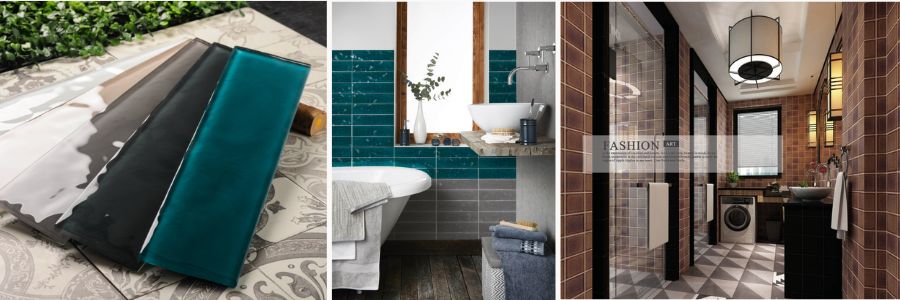
Typically used for backsplashes and decorative accents:
- Glass tiles: Reflective, vibrant colors, and contemporary feel
- Mosaic tiles: Small pieces arranged in patterns, often on mesh backing
Types of Wood Flooring
When comparing tile vs wood flooring, it’s important to understand the variety of wood options available:
Solid Hardwood
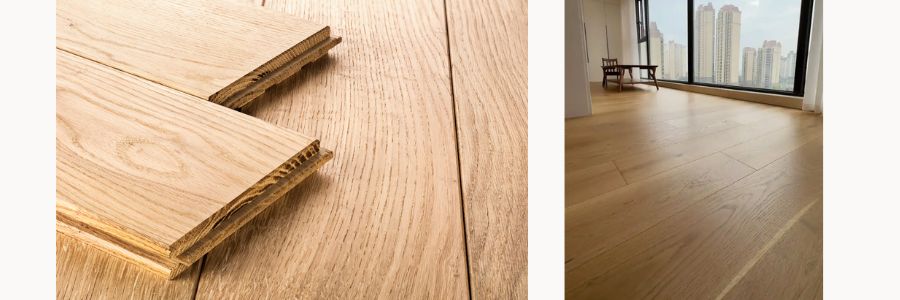
Traditional solid wood planks offer:
- Natural beauty with unique grain patterns
- Ability to be refinished multiple times
- Long lifespan (50+ years with proper care)
- Varieties including oak, maple, walnut, cherry, and exotic species
- Higher price point than engineered options
Engineered Wood Flooring
These multi-layer products feature:
- Real wood veneer on top
- Plywood or high-density fiberboard base
- Better stability in changing humidity
- Wider installation possibilities (including below grade)
- Generally lower cost than solid hardwood
Laminate Wood Flooring
This budget-friendly option includes:
- High-density fiberboard core
- Photographic layer that mimics wood
- Protective wear layer on top
- Easy click-lock installation
- Good resistance to scratches and fading
Bamboo Flooring
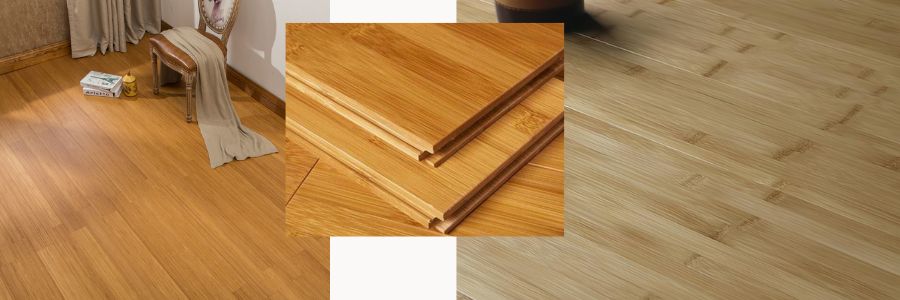
Though technically a grass, bamboo is marketed as a wood alternative:
- Renewable resource (grows much faster than trees)
- Similar hardness to mid-range hardwoods
- Available in natural, carbonized, and strand-woven varieties
- Modern, distinctive appearance
- Good eco-friendly option
Cork Flooring
Another alternative wood option:
- Harvested from cork oak trees (bark only, trees remain alive)
- Soft and warm underfoot
- Natural sound and thermal insulation
- Hypoallergenic and antimicrobial properties
- Less common but growing in popularity
Pros and Cons: Tile Flooring
When evaluating tile and hardwood flooring for your import business, consider these advantages and disadvantages of tile:
Advantages of Tile Flooring
- Superior Durability: Quality tiles can last 50+ years with minimal wear.
- Water Resistance: Ideal for bathrooms, kitchens, and humid climates.
- Easy Maintenance: Simple cleaning with water and mild detergent.
- Hypoallergenic Properties: Doesn’t harbor dust mites, pollen, or pet dander.
- Fire Resistance: Won’t burn or emit toxic fumes.
- Design Versatility: Endless colors, patterns, and sizes.
- Works with Radiant Heating: Excellent thermal conductor.
- Indoor/Outdoor Continuity: Same material can flow from inside to outside.
Disadvantages of Tile Flooring
- Hard Surface: Can be uncomfortable for extended standing.
- Cold Underfoot: Feels cool in winter (though this is an advantage in hot climates).
- Installation Complexity: Requires skilled labor and special tools.
- Grout Maintenance: Grout lines can stain and may need periodic resealing.
- Heaviness: May not be suitable for upper floors with weight restrictions.
- Slippery When Wet: Smooth glazed tiles can be hazardous (though textured options exist).
- Dropped Items Break Easily: Hard surface offers no forgiveness for glassware or dishes.
Special Considerations for Importers
When importing tile:
- Higher shipping costs due to weight
- More breakage concerns during transit
- Needs careful packaging and crating
- Different size standards across markets (metric vs. imperial)
Pros and Cons: Wood Flooring
Now let’s examine the other side of the tile vs wood flooring comparison:
Advantages of Wood Flooring
- Natural Warmth: Both visual warmth and physical warmth underfoot.
- Timeless Appeal: Classic look that rarely goes out of style.
- Comfort Underfoot: Slight give provides more comfortable standing.
- Faster Installation: Especially with engineered and click-lock systems.
- Acoustics: Less echo and noise than hard tile surfaces.
- Refinishing Potential: Solid hardwood can be sanded and refinished multiple times.
- Value Addition: Often increases property values and buyer appeal.
- Lighter Weight: Less structural load than most tiles.
Disadvantages of Wood Flooring
- Water Sensitivity: Can warp, swell, or stain with moisture exposure.
- Scratch Vulnerability: Shows wear from pet claws, furniture, and high heels.
- UV Fading: Can discolor with prolonged sun exposure.
- Higher Maintenance: Requires more careful cleaning and periodic refinishing.
- Not Ideal for Allergies: Can trap dust and allergens between boards.
- Humidity Concerns: Expands and contracts with seasonal humidity changes.
- Limited Outdoor Applications: Not suitable for exterior use (except special treated products).
Special Considerations for Importers
When importing wood flooring:
- Shipping in climate-controlled containers may be necessary
- Strict regulations regarding wood sourcing and treatment
- Country-specific certification requirements (FSC, PEFC, etc.)
- Acclimation period needed before installation
Cost Comparison Analysis: Tile vs Wood Flooring
One of the most important factors in the tile and wood flooring decision is cost. Let’s break it down:
Initial Purchase Price Comparison ( just for reference )
| Flooring Type | Low-End Price/sqm | Mid-Range Price/sqm | High-End Price/sqm |
|---|---|---|---|
| Ceramic Tile | $15-25 | $25-40 | $40-80+ |
| Porcelain Tile | $20-35 | $35-60 | $60-120+ |
| Natural Stone | $40-60 | $60-100 | $100-200+ |
| Laminate | $10-20 | $20-35 | $35-50 |
| Engineered Wood | $25-45 | $45-75 | $75-120+ |
| Solid Hardwood | $40-70 | $70-100 | $100-200+ |
“Price points vary significantly across markets, but the relative positioning usually remains consistent – with laminate as the most affordable option and high-end natural stone or exotic hardwoods at the premium level.”
Installation Cost Differences
Installation costs also vary between tile and wood flooring:
- Tile installation typically ranges from $30-50 per square meter (labor only)
- Wood flooring installation typically ranges from $20-40 per square meter (labor only)
Tile installation generally costs more because it requires:
- More surface preparation
- Special cutting tools
- Multiple days of work (including drying time)
- More specialized skills
Long-Term Cost Analysis
When considering tile or wood flooring over a 20-year period:
Tile Flooring:
- Initial cost (mid-range porcelain): $50/sqm + $40/sqm installation = $90/sqm
- Maintenance (20 years): Basic cleaning supplies + occasional grout cleaning = ~$5/sqm
- Potential repairs: Minimal, perhaps $5/sqm for occasional grout repair or tile replacement
- Total 20-year cost: ~$100/sqm
Solid Hardwood Flooring:
- Initial cost (mid-range oak): $85/sqm + $30/sqm installation = $115/sqm
- Maintenance (20 years): Regular cleaning + refinishing every 7-10 years (3x) at $20/sqm = $60/sqm
- Total 20-year cost: ~$175/sqm
This simplified analysis shows why tile often wins the long-term cost comparison, despite potentially higher upfront costs in some cases.
Lifespan and Durability Comparison
The expected lifespan is a key factor when evaluating wood and tile flooring:
Tile Flooring Lifespan
| Tile Type | Expected Lifespan | Factors Affecting Durability |
|---|---|---|
| Ceramic | 15-30 years | Quality, thickness, installation |
| Porcelain | 50+ years | Rarely wears out if properly installed |
| Natural Stone | 100+ years | Type of stone, sealing, maintenance |
| Cement/Terrazzo | 75+ years | Quality of materials, installation |
| Glass/Mosaic | 20+ years | Traffic level, quality of installation |
Wood Flooring Lifespan
| Wood Type | Expected Lifespan | Factors Affecting Durability |
|---|---|---|
| Solid Hardwood | 50-100+ years | Species hardness, maintenance, refinishing |
| Engineered Wood | 20-40 years | Veneer thickness, core quality, moisture exposure |
| Laminate | 10-25 years | Wear layer quality, moisture exposure, installation |
| Bamboo | 20-50 years | Processing method, quality, moisture levels |
| Cork | 10-30 years | Quality, sealing, traffic levels |
Key Durability Factors
The wood and tile flooring durability debate depends largely on:
- Usage Environment: Tile excels in wet or high-traffic areas, wood in controlled environments
- Maintenance Practices: Both require appropriate care to reach maximum lifespan
- Quality of Materials: Higher-grade products last significantly longer
- Professional Installation: Improper installation reduces lifespan dramatically
Application and Use Case Comparison
Different spaces call for different solutions in the tile and wood flooring decision:
Best Applications for Tile Flooring
Tile excels in:
- Bathrooms and showers: Due to superior water resistance
- Kitchens: Stands up to spills and heavy use
- Entryways: Handles dirt and moisture from outdoors
- Sunrooms: Resists UV fading
- Outdoor spaces: Porcelain works for patios and pool decks
- Commercial settings: Holds up to heavy foot traffic
- Hot climates: Keeps spaces cooler
Best Applications for Wood Flooring
Wood shines in:
- Living rooms: Provides warmth and comfort
- Bedrooms: Cozy underfoot for bare feet
- Dining rooms: Classic, elegant appearance
- Home offices: Warm, professional look
- Upper floors: Lighter weight and quieter
- Moderate climates: Performs best in stable humidity
- Historic renovations: Authentic period look
Climate and Environmental Considerations
The wood vs tile flooring choice is heavily influenced by local climate:
| Climate Type | Better Option | Reasoning |
|---|---|---|
| Tropical/Humid | Tile | Resists moisture, prevents mold, stays cool |
| Desert/Hot | Tile | Stays cool, won’t dry out or crack |
| Moderate | Either | Both perform well with proper care |
| Cold/Dry | Wood | Provides warmth, less concern about humidity damage |
| Coastal | Tile | Resists salt air and humidity |
| High Altitude | Wood | Better insulation in cold temperatures |
Commercial vs Residential Applications
When advising clients on tile and wood flooring:
Commercial spaces generally favor tile because of:
- Lower maintenance requirements
- Longer lifespan in high-traffic areas
- Better durability against rolling loads
- Easier cleaning with commercial methods
- Superior fire ratings for building codes
Residential spaces often favor wood because of:
- Warmth and comfort underfoot
- Perceived higher value
- Traditional residential aesthetic
- Less echo and noise
- Easier DIY installation (in some cases)
Regional Market Opportunities
Understanding regional preferences helps importers target the right markets for tile vs wood flooring:
North American Market
- United States: Strong preference for hardwood in luxury homes, tile in bathrooms/kitchens and southern states
- Canada: Growing market for porcelain tile with wood-look designs, traditional preference for hardwood
- Mexico: Predominantly tile market, especially in ceramic due to climate and cost factors
European Market
- Mediterranean Countries: Strong tile tradition (Italy, Spain, Greece)
- Northern Europe: Preference for wood in living spaces, tile in wet areas
- UK: Mixed market with growing demand for luxury vinyl as a wood alternative
Asian and Middle Eastern Markets
- Japan: Traditional wood preference, high standards for quality
- Middle East: Predominantly tile due to climate, high-end marble for luxury projects
Emerging Markets
- Brazil: Growing wood flooring demand despite traditional tile preference
- India: Primarily tile with growing marble and granite segment
- Southeast Asia: Climate favors tile, but increasing interest in engineered wood
Designing Mixed-Material Spaces
One exciting trend is combining tile and wood flooring in the same project:
Transition Techniques
Successful material transitions include:
- Straight line transitions: Using metal T-bars or flush transitions
- Room-by-room approach: Tile in wet areas, wood in living spaces
- Inset designs: Tile “rugs” within wood floors or vice versa
- Diagonal transitions: Creating visual interest at material changes
Creative Combination Ideas
Designers are increasingly using tile and hardwood flooring as complementary elements:
- Wood-look tile alongside real wood for water-prone areas
- Decorative tile borders framing wood sections
- Hexagonal tile inserts within wood plank installations
- Wood in bedrooms transitioning to tile in ensuite bathrooms
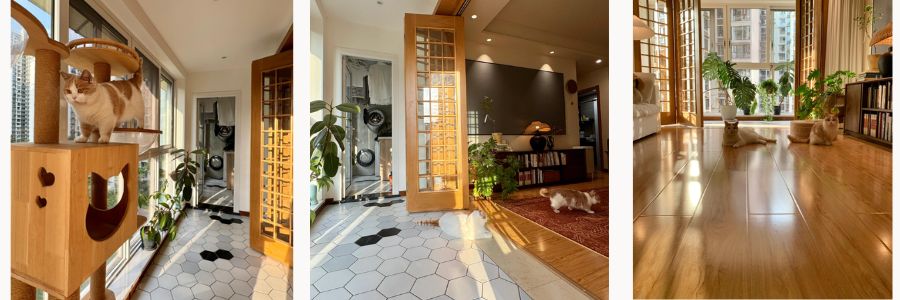
Sustainability and Environmental Considerations
Environmental factors are increasingly important in the tile or wood flooring decision:
Environmental Impact Comparison
Tile Sustainability Factors:
- Long lifespan reduces replacement frequency
- Inert material doesn’t emit VOCs
- Many options with recycled content
- Energy-intensive production process
- Heavy weight increases transportation footprint
Wood Sustainability Factors:
- Renewable resource (if properly harvested)
- Stores carbon during its lifetime
- Biodegradable at end of life
- Requires forest management consideration
- Some finishes may contain VOCs
Important Certifications
When importing environmentally conscious tile or wood flooring:
Tile Certifications:
- Green Squared
- CE Certification
- EPD (Environmental Product Declaration)
Wood Certifications:
- FSC (Forest Stewardship Council)
- PEFC (Programme for Endorsement of Forest Certification)
- SFI (Sustainable Forestry Initiative)
- CARB compliance for formaldehyde
End-User Education: Helping Your Customers Sell Both Options
To maximize your opportunities in both tile and wood flooring markets:
Key Selling Points for Tile
Train your distribution partners to emphasize:
- Longevity and durability
- Ease of maintenance
- Water and stain resistance
- Design versatility
- Indoor/outdoor compatibility
- Lower lifetime cost
Key Selling Points for Wood
For wood flooring, the focus should be on:
- Natural warmth and beauty
- Comfort underfoot
- Classic, timeless appeal
- Potential for refinishing
- Added home value
- Unique character and grain patterns
Matching Products to Customer Needs
Help your retailers ask the right questions:
- What rooms need flooring?
- Local climate conditions?
- Presence of children or pets?
- Maintenance preferences?
- Design aesthetic goals?
- Budget constraints (immediate vs. long-term)?
Conclusion
As an importer, the tile vs wood flooring comparison isn’t about picking a winner – it’s about understanding each product’s strengths to serve your market effectively.
The flooring market continues to evolve with interesting developments:
- Wood-look porcelain capturing market share from real wood in moisture-prone areas
- Engineered products improving in both categories
- Sustainability becoming a major purchasing factor
- Mixed-material designs growing in popularity
By offering both tile and wood flooring options, you can:
- Serve a broader customer base
- Provide complete solutions for whole-house projects
- Adapt to seasonal and regional preferences
- Balance inventory against market fluctuations
At Tiles & Bathroom, we specialize in high-quality porcelain and ceramic tiles, including our popular wood-look collections that offer the best of both worlds. Contact us to discuss how we can help expand your product offerings with competitive pricing and reliable quality.
FAQ:
Q: Which is better for homes with children and pets, tile or wood flooring?
A: Tile generally offers better resistance to scratches, spills, and stains, making it more durable for active households with children and pets.
Q: Does wood flooring really add more value to a home than tile?
A: In most markets, hardwood flooring typically adds more resale value to homes than tile, though this varies by region and is changing as luxury tile options gain popularity.
Q: How do tile and wood flooring compare in terms of maintenance? A: Tile requires less routine maintenance and rarely needs replacement, while wood floors need periodic refinishing but can be brought back to like-new condition multiple times over their lifespan.
Q: Can you put radiant heating under both tile and wood flooring?
A: Yes, but tile conducts heat more efficiently, making it the better partner for radiant heating systems. Engineered wood works better than solid hardwood over radiant heat.
Q: Which flooring type is more eco-friendly?
A: Both can be eco-friendly depending on sourcing and manufacturing. Sustainably harvested wood stores carbon, while tile’s extremely long lifespan means less frequent replacement.
Q: What’s the best flooring option for someone with allergies?
A: Tile is generally considered better for allergy sufferers as it doesn’t harbor dust, pollen, or pet dander, and can be completely sanitized.
Related Posts:
Creative Wood Tile Patterns That Will Make Your Floors Stand Out
Porcelain Wood Tile Pros and Cons: A Supplier’s Insider Perspective
The ultimate guide to buying China tile – everything you need to know


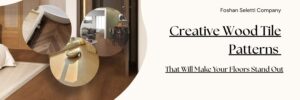


One Response